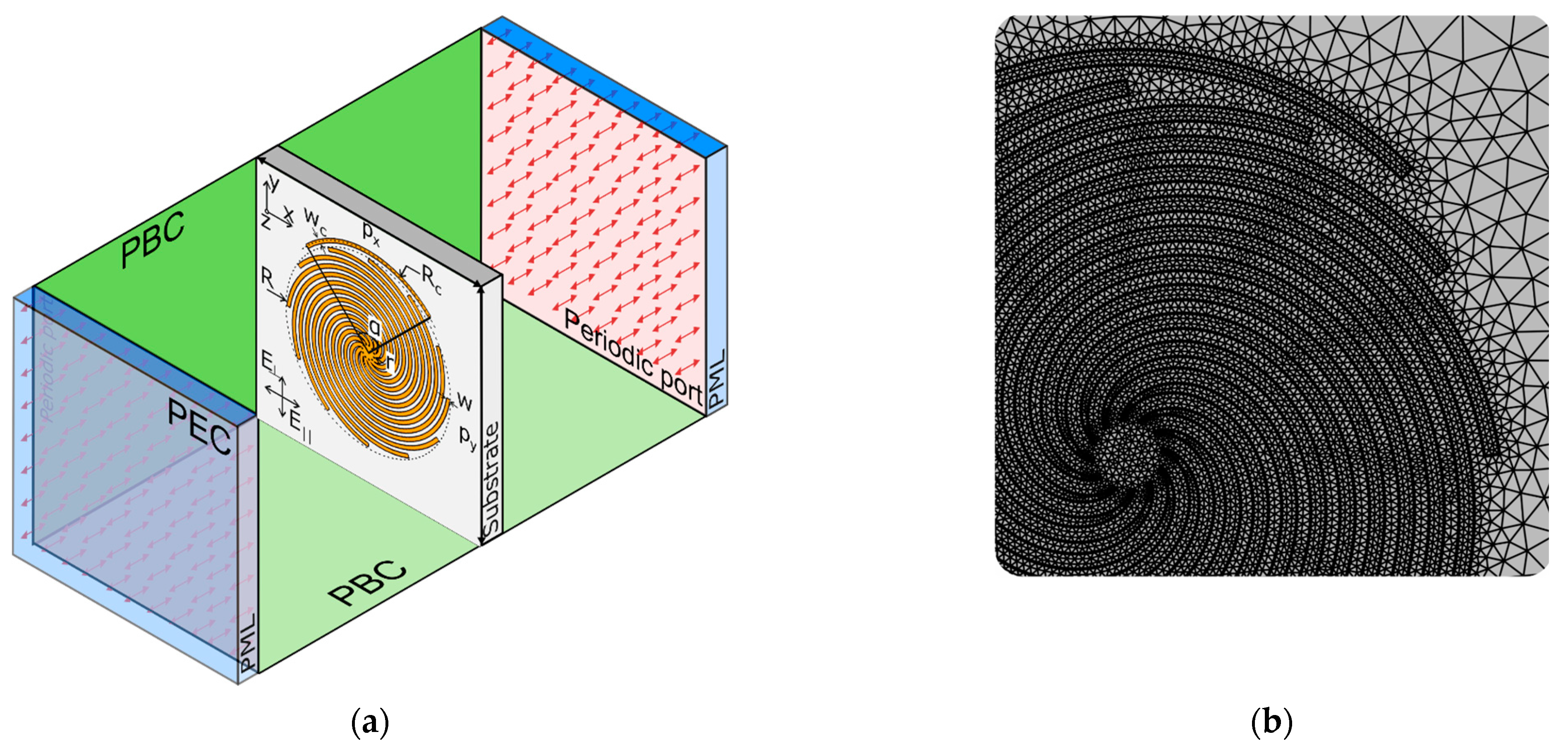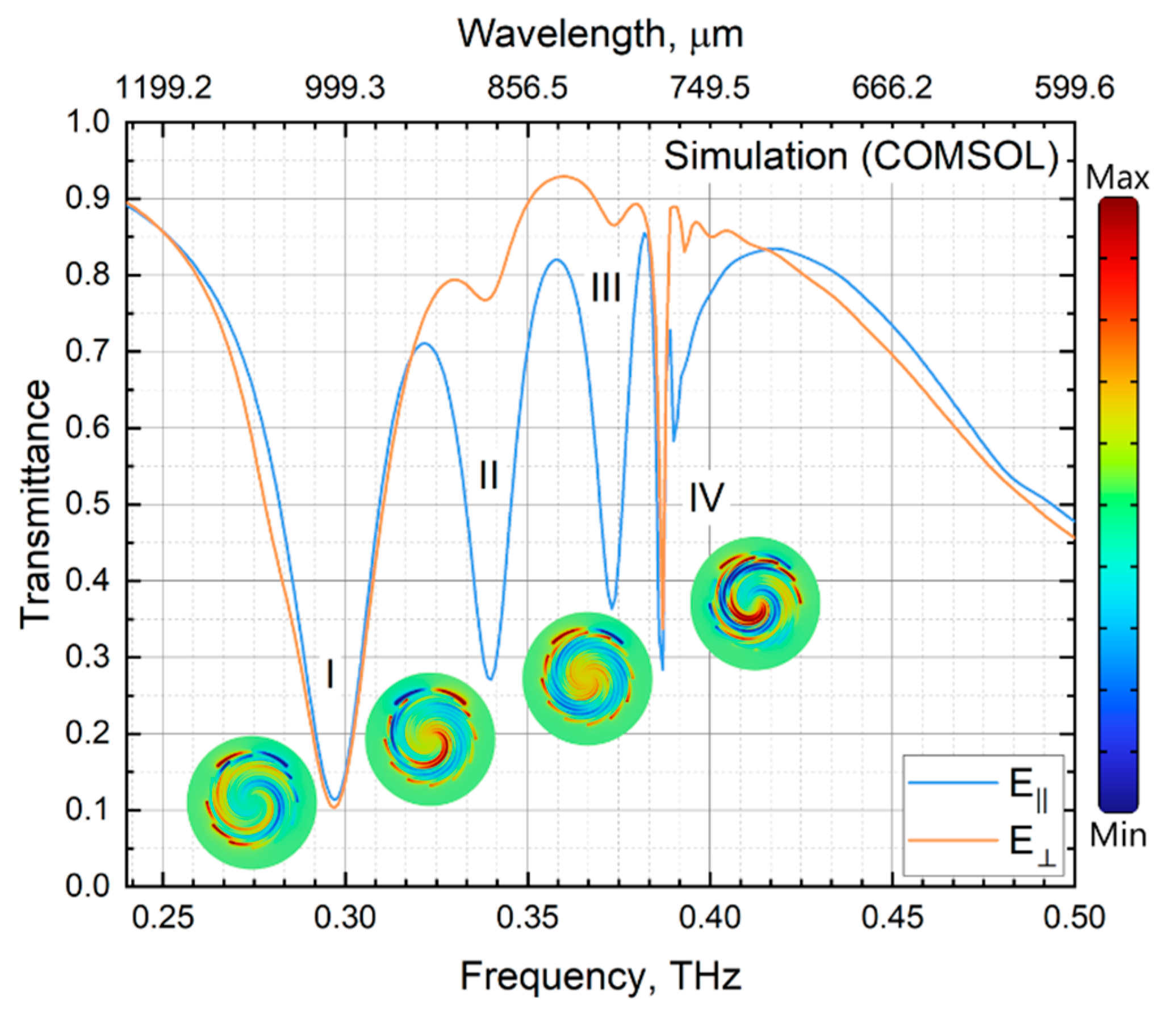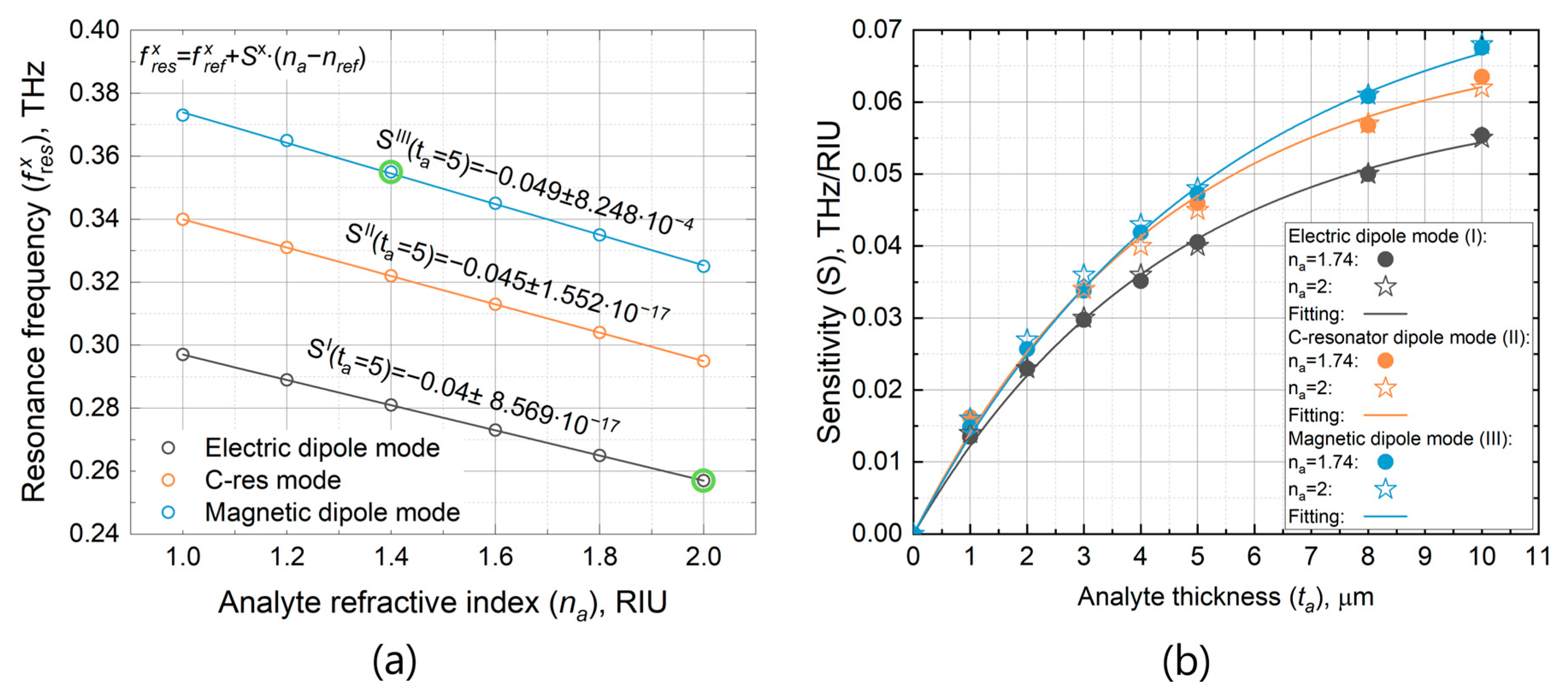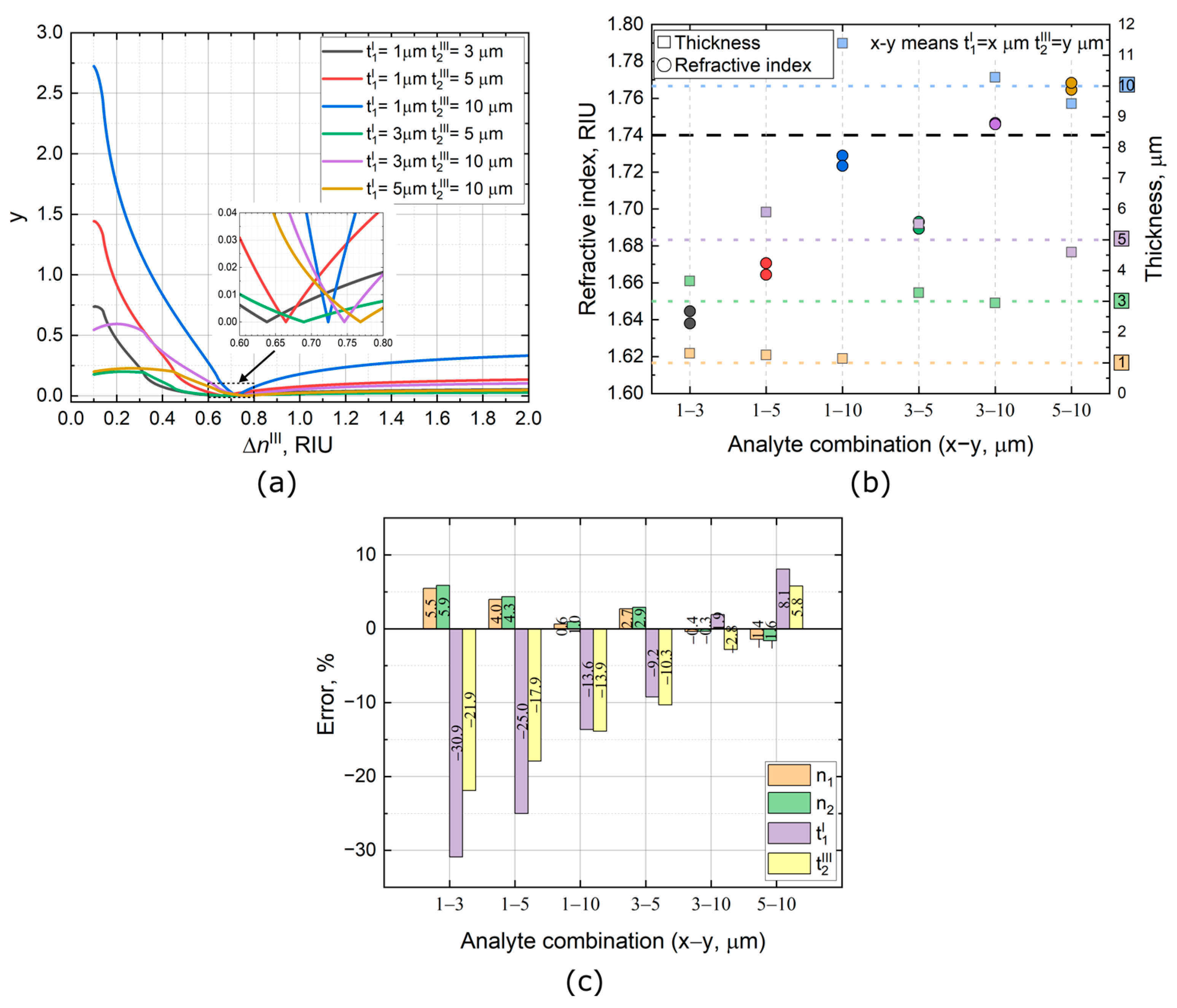Principles of Measuring Thickness and Refractive Index of Thin Dielectric Film by Using Multiresonance Archimedean Spiral Metasurfaces with C Resonator in the Terahertz Frequency Range
Abstract
1. Introduction
2. Materials and Methods
3. Transmission Refractometry Measurement
- (i)
- Diaphragm measuring.
- (ii)
- Measuring bare metasurface.
- (iii)
- Measuring metasurface covered by analyte.
4. Refractive Index Sensitivity
5. Measurement Principles
- A.
- The real part of the refractive index is known.
- B.
- The film thickness is known.
- C.
- Only the sensitivity of the multiresonance metasurface is known.
5.1. Saturation Measurement
5.2. Nonlinear Measurement
6. Conclusions
Author Contributions
Funding
Institutional Review Board Statement
Informed Consent Statement
Data Availability Statement
Acknowledgments
Conflicts of Interest
References
- Markelz, A.G.; Mittleman, D.M. Perspective on Terahertz Applications in Bioscience and Biotechnology. ACS Photonics 2022, 9, 1117–1126. [Google Scholar] [CrossRef]
- Cuisset, A.; Hindle, F.; Mouret, G.; Bocquet, R.; Bruckhuisen, J.; Decker, J.; Pienkina, A.; Bray, C.; Fertein, É.; Boudon, V. Terahertz Rotational Spectroscopy of Greenhouse Gases Using Long Interaction Path-Lengths. Appl. Sci. 2021, 11, 1229. [Google Scholar] [CrossRef]
- Smolyanskaya, O.A.; Chernomyrdin, N.V.; Konovko, A.A.; Zaytsev, K.I.; Ozheredov, I.A.; Cherkasova, O.P.; Nazarov, M.M.; Guillet, J.-P.; Kozlov, S.A.; Kistenev, Y.V.; et al. Terahertz Biophotonics as a Tool for Studies of Dielectric and Spectral Properties of Biological Tissues and Liquids. Prog. Quantum Electron. 2018, 62, 1–77. [Google Scholar] [CrossRef]
- Naftaly, M.; Vieweg, N.; Deninger, A. Industrial Applications of Terahertz Sensing: State of Play. Sensors 2019, 19, 4203. [Google Scholar] [CrossRef] [PubMed]
- Yan, Z.; Zhu, L.-G.; Meng, K.; Huang, W.; Shi, Q. THz Medical Imaging: From in Vitro to in Vivo. Trends Biotechnol. 2022, 40, 816–830. [Google Scholar] [CrossRef] [PubMed]
- Wei, L.; Yu, L.; Jiaoqi, H.; Guorong, H.; Yang, Z.; Weiling, F. Application of Terahertz Spectroscopy in Biomolecule Detection. Front. Lab. Med. 2018, 2, 127–133. [Google Scholar] [CrossRef]
- Akter, N.; Hasan, M.; Pala, N. A Review of THz Technologies for Rapid Sensing and Detection of Viruses Including SARS-CoV-2. Biosensors 2021, 11, 349. [Google Scholar] [CrossRef] [PubMed]
- Koch, M.; Mittleman, D.M.; Ornik, J.; Castro-Camus, E. Terahertz Time-Domain Spectroscopy. Nat. Rev. Methods Primers 2023, 3, 48. [Google Scholar] [CrossRef]
- Withayachumnankul, W.; O’Hara, J.F.; Cao, W.; Al-Naib, I.; Zhang, W. Limitation in Thin-Film Sensing with Transmission-Mode Terahertz Time-Domain Spectroscopy. Opt. Express 2014, 22, 972. [Google Scholar] [CrossRef]
- Laman, N.; Harsha, S.S.; Grischkowsky, D.; Melinger, J.S. High-Resolution Waveguide THz Spectroscopy of Biological Molecules. Biophys. J. 2008, 94, 1010–1020. [Google Scholar] [CrossRef]
- Razanoelina, M.; Kinjo, R.; Takayama, K.; Kawayama, I.; Murakami, H.; Mittleman, D.M.; Tonouchi, M. Parallel-Plate Waveguide Terahertz Time Domain Spectroscopy for Ultrathin Conductive Films. J. Infrared Millim. Terahertz Waves 2015, 36, 1182–1194. [Google Scholar] [CrossRef]
- Islam, M.; Kumar Bhowmik, B.; Dhriti, K.M.; Minakshi; Mohan, D.; Ahmad, A.; Kumar, G. Thin Film Sensing in a Planar Terahertz Meta-Waveguide. J. Opt. 2022, 24, 064016. [Google Scholar] [CrossRef]
- Zhao, Y.; Vora, K.; Liu, X.; Bögel, G.V.; Seidl, K.; Balzer, J.C. Photonic Crystal Resonator in the Millimeter/Terahertz Range as a Thin Film Sensor for Future Biosensor Applications. J. Infrared Millim. Terahertz Waves 2022, 43, 426–444. [Google Scholar] [CrossRef]
- Ng, B.; Wu, J.; Hanham, S.M.; Fernández-Domínguez, A.I.; Klein, N.; Liew, Y.F.; Breese, M.B.H.; Hong, M.; Maier, S.A. Spoof Plasmon Surfaces: A Novel Platform for THz Sensing. Adv. Opt. Mater. 2013, 1, 543–548. [Google Scholar] [CrossRef]
- Beruete, M.; Jáuregui-López, I. Terahertz Sensing Based on Metasurfaces. Adv. Opt. Mater. 2020, 8, 1900721. [Google Scholar] [CrossRef]
- O’Hara, J.F.; Withayachumnankul, W.; Al-Naib, I. A Review on Thin-Film Sensing with Terahertz Waves. J. Infrared Millim. Terahertz Waves 2012, 33, 245–291. [Google Scholar] [CrossRef]
- Ali, A.; Mitra, A.; Aïssa, B. Metamaterials and Metasurfaces: A Review from the Perspectives of Materials, Mechanisms and Advanced Metadevices. Nanomaterials 2022, 12, 1027. [Google Scholar] [CrossRef] [PubMed]
- Pors, A.; Moreno, E.; Martin-Moreno, L.; Pendry, J.B.; Garcia-Vidal, F.J. Localized Spoof Plasmons Arise While Texturing Closed Surfaces. Phys. Rev. Lett. 2012, 108, 223905. [Google Scholar] [CrossRef] [PubMed]
- Peng, Y.; Shi, C.; Zhu, Y.; Gu, M.; Zhuang, S. Terahertz Spectroscopy in Biomedical Field: A Review on Signal-to-Noise Ratio Improvement. PhotoniX 2020, 1, 12. [Google Scholar] [CrossRef]
- Ajayan, J.; Sreejith, S.; Manikandan, M.; Lai, W.-C.; Saha, S. Terahertz Sensors for next Generation Biomedical and Other Industrial Electronics Applications: A Critical Review. Sens. Actuators A Phys. 2024, 369, 115169. [Google Scholar] [CrossRef]
- Shen, S.; Liu, X.; Shen, Y.; Qu, J.; Pickwell-MacPherson, E.; Wei, X.; Sun, Y. Recent Advances in the Development of Materials for Terahertz Metamaterial Sensing. Adv. Opt. Mater. 2022, 10, 2101008. [Google Scholar] [CrossRef]
- Zhang, X.; Cui, W.Y.; Lei, Y.; Zheng, X.; Zhang, J.; Cui, T.J. Spoof Localized Surface Plasmons for Sensing Applications. Adv. Mater. Technol. 2021, 6, 2000863. [Google Scholar] [CrossRef]
- Park, S.J.; Yoon, S.A.N.; Ahn, Y.H. Dielectric Constant Measurements of Thin Films and Liquids Using Terahertz Metamaterials. RSC Adv. 2016, 6, 69381–69386. [Google Scholar] [CrossRef]
- Park, S.J.; Cha, S.H.; Shin, G.A.; Ahn, Y.H. Sensing Viruses Using Terahertz Nano-Gap Metamaterials. Biomed. Opt. Express 2017, 8, 3551. [Google Scholar] [CrossRef]
- Yang, J.; Qi, L.; Li, B.; Wu, L.; Shi, D.; Ahmed Uqaili, J.; Tao, X. A Terahertz Metamaterial Sensor Used for Distinguishing Glucose Concentration. Results Phys. 2021, 26, 104332. [Google Scholar] [CrossRef]
- Lee, G.; Cho, Y.; Ok, G. Improved Analysis of THz Metamaterials for Glucose Sensing Based on Modified Lorentz Dispersion Model. Spectrochim. Acta Part A Mol. Biomol. Spectrosc. 2023, 293, 122519. [Google Scholar] [CrossRef]
- Lee, D.-K.; Kang, J.-H.; Kwon, J.; Lee, J.-S.; Lee, S.; Woo, D.H.; Kim, J.H.; Song, C.-S.; Park, Q.-H.; Seo, M. Nano Metamaterials for Ultrasensitive Terahertz Biosensing. Sci. Rep. 2017, 7, 8146. [Google Scholar] [CrossRef] [PubMed]
- Krasnok, A.; Tymchenko, M.; Alù, A. Nonlinear Metasurfaces: A Paradigm Shift in Nonlinear Optics. Mater. Today 2018, 21, 8–21. [Google Scholar] [CrossRef]
- Zhang, M.; Guo, G.; Xu, Y.; Yao, Z.; Zhang, S.; Yan, Y.; Tian, Z. Exploring the Application of Multi-Resonant Bands Terahertz Metamaterials in the Field of Carbohydrate Films Sensing. Biosensors 2023, 13, 606. [Google Scholar] [CrossRef]
- Yuan, T.; Wu, J.; Xu, X.; Liu, J.; Du, Y. Multi-Resonant Tunable Absorber of Terahertz Metamaterial Based on GaAs and VO2. Results Phys. 2023, 49, 106519. [Google Scholar] [CrossRef]
- Ou, H.; Lu, F.; Xu, Z.; Lin, Y.-S. Terahertz Metamaterial with Multiple Resonances for Biosensing Application. Nanomaterials 2020, 10, 1038. [Google Scholar] [CrossRef] [PubMed]
- Liao, Z.; Liu, S.; Ma, H.F.; Li, C.; Jin, B.; Cui, T.J. Electromagnetically Induced Transparency Metamaterial Based on Spoof Localized Surface Plasmons at Terahertz Frequencies. Sci. Rep. 2016, 6, 27596. [Google Scholar] [CrossRef] [PubMed]
- Gao, Z.; Wu, L.; Gao, F.; Luo, Y.; Zhang, B. Spoof Plasmonics: From Metamaterial Concept to Topological Description. Adv. Mater. 2018, 30, 1706683. [Google Scholar] [CrossRef] [PubMed]
- Gao, Z.; Gao, F.; Zhang, Y.; Zhang, B. Deep-Subwavelength Magnetic-Coupling-Dominant Interaction among Magnetic Localized Surface Plasmons. Phys. Rev. B 2016, 93, 195410. [Google Scholar] [CrossRef]
- Gerasimov, V.V.; Kuznetsov, S.A.; Lemzyakov, A.G.; Hafizov, R.R. Studying Localized Surface Plasmon Resonances in the THz Region for Subwavelength Spiral Disks. J. Phys. Conf. Ser. 2020, 1461, 012048. [Google Scholar] [CrossRef]
- Huang, Y.; Zhang, J.; Cui, T.J.; Liao, Z.; Zhang, D.H. Revealing the Physical Mechanisms behind Large Field Enhancement in Hybrid Spoof Plasmonic Systems. J. Opt. Soc. Am. B 2018, 35, 396. [Google Scholar] [CrossRef]
- Huidobro, P.A.; Shen, X.; Cuerda, J.; Moreno, E.; Martin-Moreno, L.; Garcia-Vidal, F.J.; Cui, T.J.; Pendry, J.B. Magnetic Localized Surface Plasmons. Phys. Rev. X 2014, 4, 021003. [Google Scholar] [CrossRef]
- Liao, Z.; Fernández-Domínguez, A.I.; Zhang, J.; Maier, S.A.; Cui, T.J.; Luo, Y. Homogenous Metamaterial Description of Localized Spoof Plasmons in Spiral Geometries. ACS Photonics 2016, 3, 1768–1775. [Google Scholar] [CrossRef]
- Liao, Z.; Shen, X.; Pan, B.C.; Zhao, J.; Luo, Y.; Cui, T.J. Combined System for Efficient Excitation and Capture of LSP Resonances and Flexible Control of SPP Transmissions. ACS Photonics 2015, 2, 738–743. [Google Scholar] [CrossRef]
- Wang, Z.; Gao, Z.; Zhang, Y.; An, P.; Lou, J.; Cheng, P.; Zhao, H. Selectively Enhanced Magnetic Vertical Conductive Coupling among Magnetic Localized Surface Plasmons. J. Phys. D Appl. Phys. 2019, 52, 135101. [Google Scholar] [CrossRef]
- Gao, Z.; Gao, F.; Zhang, B. High-Order Spoof Localized Surface Plasmons Supported on a Complementary Metallic Spiral Structure. Sci. Rep. 2016, 6, 24447. [Google Scholar] [CrossRef] [PubMed]
- Zhang, J.; Liao, Z.; Luo, Y.; Shen, X.; Maier, S.A.; Cui, T.J. Spoof Plasmon Hybridization. Laser Photonics Rev. 2017, 11, 1600191. [Google Scholar] [CrossRef]
- Gerasimov, V.V.; Hafizov, R.R.; Kuznetsov, S.A.; Lazorskiy, P.A. Exploiting Localized Surface Plasmon Resonances in Subwavelength Spiral Disks for THz Thin Film Sensing. Appl. Sci. 2020, 10, 3595. [Google Scholar] [CrossRef]
- Kameshkov, O.; Gerasimov, V.; Kuznetsov, S. Sensing Performance Analysis of Spiral Metasurface Utilizing Phase Spectra Measurement Technique. Photonics 2023, 10, 243. [Google Scholar] [CrossRef]
- Kuznetsov, S.A.; Paulish, A.G.; Navarro-Cía, M.; Arzhannikov, A.V. Selective Pyroelectric Detection of Millimetre Waves Using Ultra-Thin Metasurface Absorbers. Sci. Rep. 2016, 6, 21079. [Google Scholar] [CrossRef] [PubMed]
- Navarro-Cia, M.; Kuznetsov, S.A.; Aznabet, M.; Beruete, M.; Falcone, F.; Ayza, M.S. Route for Bulk Millimeter Wave and Terahertz Metamaterial Design. IEEE J. Quantum Electron. 2011, 47, 375–385. [Google Scholar] [CrossRef]
- Deif, S.; Zarifi, M.H.; Daneshmand, M. Substrate Choice Impact on Microwave Sensor. In Proceedings of the 2016 17th International Symposium on Antenna Technology and Applied Electromagnetics (ANTEM), Montreal, QC, Canada, 10–13 July 2016; pp. 1–2. [Google Scholar]
- Chen, X.; Fan, W. Ultrasensitive Terahertz Metamaterial Sensor Based on Spoof Surface Plasmon. Sci. Rep. 2017, 7, 2092. [Google Scholar] [CrossRef] [PubMed]
- Shalabney, A.; Abdulhalim, I. Sensitivity-enhancement Methods for Surface Plasmon Sensors. Laser Photonics Rev. 2011, 5, 571–606. [Google Scholar] [CrossRef]
- Cong, L.; Tan, S.; Yahiaoui, R.; Yan, F.; Zhang, W.; Singh, R. Experimental Demonstration of Ultrasensitive Sensing with Terahertz Metamaterial Absorbers: A Comparison with the Metasurfaces. Appl. Phys. Lett. 2015, 106, 031107. [Google Scholar] [CrossRef]
- Chen, M.; Fan, F.; Shen, S.; Wang, X.; Chang, S. Terahertz Ultrathin Film Thickness Sensor below λ/90 Based on Metamaterial. Appl. Opt. 2016, 55, 6471. [Google Scholar] [CrossRef]
- Cheng, D.; Zhang, B.; Liu, G.; Wang, J.; Luo, Y. Terahertz Ultrasensitive Biosensing Metamaterial and Metasurface Based on Spoof Surface Plasmon Polaritons. Int. J. Numer. Model. 2020, 33, e2529. [Google Scholar] [CrossRef]




| Mode Number | I | II | III |
|---|---|---|---|
| , THz/RIU | 0.061 ± 0.0016 | 0.069 ± 0.0023 | 0.078 ± 0.0018 |
| , μm | 4.46 ± 0.24 | 4.42 ± 0.32 | 5.24 ± 0.224 |
| № | Known Characteristics | Characteristics to Find |
|---|---|---|
| A |
|
|
| B |
|
|
| C |
|
|
Disclaimer/Publisher’s Note: The statements, opinions and data contained in all publications are solely those of the individual author(s) and contributor(s) and not of MDPI and/or the editor(s). MDPI and/or the editor(s) disclaim responsibility for any injury to people or property resulting from any ideas, methods, instructions or products referred to in the content. |
© 2024 by the authors. Licensee MDPI, Basel, Switzerland. This article is an open access article distributed under the terms and conditions of the Creative Commons Attribution (CC BY) license (https://creativecommons.org/licenses/by/4.0/).
Share and Cite
Kameshkov, O.; Gerasimov, V. Principles of Measuring Thickness and Refractive Index of Thin Dielectric Film by Using Multiresonance Archimedean Spiral Metasurfaces with C Resonator in the Terahertz Frequency Range. Photonics 2024, 11, 529. https://doi.org/10.3390/photonics11060529
Kameshkov O, Gerasimov V. Principles of Measuring Thickness and Refractive Index of Thin Dielectric Film by Using Multiresonance Archimedean Spiral Metasurfaces with C Resonator in the Terahertz Frequency Range. Photonics. 2024; 11(6):529. https://doi.org/10.3390/photonics11060529
Chicago/Turabian StyleKameshkov, Oleg, and Vasily Gerasimov. 2024. "Principles of Measuring Thickness and Refractive Index of Thin Dielectric Film by Using Multiresonance Archimedean Spiral Metasurfaces with C Resonator in the Terahertz Frequency Range" Photonics 11, no. 6: 529. https://doi.org/10.3390/photonics11060529
APA StyleKameshkov, O., & Gerasimov, V. (2024). Principles of Measuring Thickness and Refractive Index of Thin Dielectric Film by Using Multiresonance Archimedean Spiral Metasurfaces with C Resonator in the Terahertz Frequency Range. Photonics, 11(6), 529. https://doi.org/10.3390/photonics11060529





